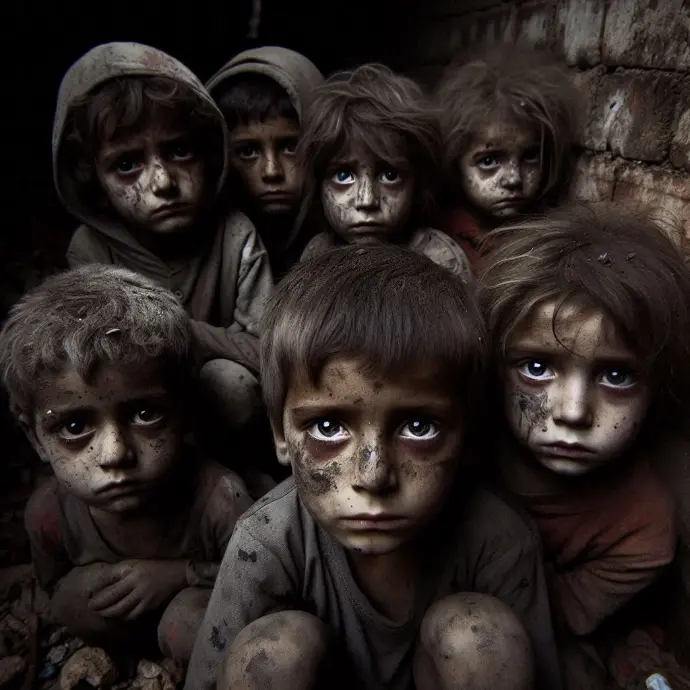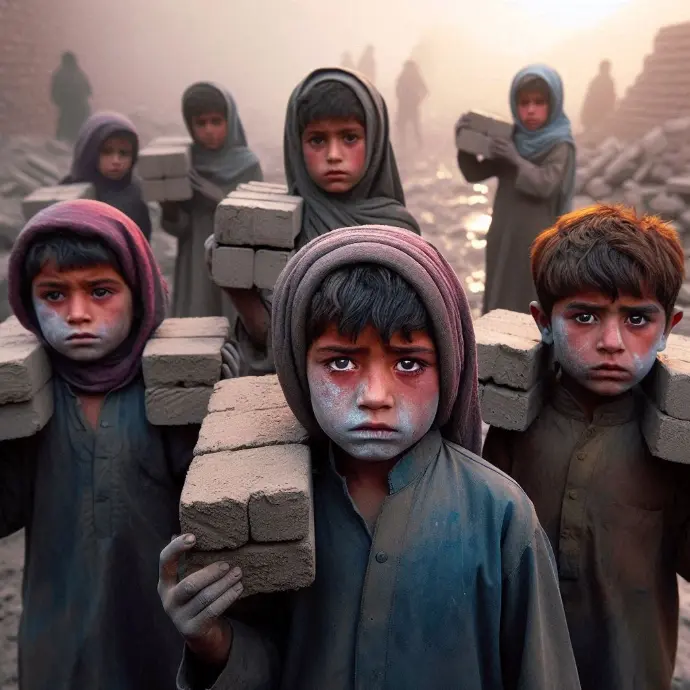
Working children and education: seeking solutions to reconcile rights and realities
On our website you will find an in-depth analysis of human rights worldwide. On this occasion, we will explore the topic of "Working children and education: seeking solutions to reconcile rights and realities." Find out how we face the challenge of reconciling children's rights to education and a safe work environment.
Introduction
In the current global context, the problem of child labourers continues to be a major challenge in the field of human rights. Despite international efforts to eradicate this practice, millions of children around the world are forced to work in precarious conditions, depriving them of their right to a full childhood and an adequate education.
Child labourers face a series of difficulties that affect their physical, emotional and educational well-being. Many of them are forced to perform dangerous work, with exhausting hours and unfair wages, which puts their comprehensive development at risk. This reality is especially worrying in those countries where labour laws do not adequately protect minors or where extreme poverty forces families to resort to child labour as their only source of income.
The lack of access to quality education is one of the most serious consequences of child labour, as it limits the opportunities for these children to break the cycle of poverty and improve their living conditions in the future. The combination of work and lack of education perpetuates inequality and makes it difficult for them to fully exercise their fundamental rights. Given this reality, it is essential to understand the importance of education in the comprehensive development of working children and to seek solutions to make their labour rights compatible with their right to education.
Education plays a crucial role in the development of working children, as it provides them with the tools necessary to break the cycle of poverty and achieve a brighter future. By receiving a quality education, these children have the opportunity to acquire skills that will allow them to access better job opportunities in the future, moving them away from dangerous and poorly paid jobs.
In addition, education provides working children with a safe space where they can develop their social, emotional and intellectual skills, allowing them to explore their potential and build strong self-esteem. It also gives them the opportunity to acquire knowledge that allows them to understand and exercise their rights, empowering them to become defenders of their own dignity and that of others.
Promoting the education of working children not only benefits them at an individual level, but also contributes to the sustainable development of communities and societies as a whole, by promoting equal opportunities and building a more just and equitable society.
Despite the efforts made at the international level to address the problem of child labour and promote quality education for all, the current reality shows that much remains to be done. The compatibility of the labour rights of working children with their right to education remains a complex challenge, which requires comprehensive and coordinated strategies at the global, national and local levels.
It is essential that governments, international organisations, civil society and the private sector work closely together to design and implement policies and programmes that ensure that working children have access to quality education, without having to give up their labour rights. This implies addressing the structural causes of child labour, such as poverty, lack of opportunities and discrimination, while strengthening educational systems and promoting the active participation of communities in the protection of children's rights.
In this regard, it is necessary to promote intersectoral dialogue and collaboration between key actors, as well as increasing investment in inclusive educational programmes adapted to the specific needs of working children. Only through a comprehensive and coordinated approach will it be possible to move towards building a more just and equitable future for all children, where child labour is eradicated and education is an accessible right for each of them.
Challenges of reconciling rights
Child labour has a significant impact on children's education, as many of them are forced to drop out of school to contribute financially to their families. This situation leads to a decrease in school enrolment rates and an increase in the risk of child labourers falling into a cycle of poverty and lack of educational opportunities.
In addition, child labour often involves long hours of labour, leaving children with little time or energy to devote to their studies. The resulting fatigue and stress can negatively affect their academic performance and their ability to absorb and retain knowledge.
It is crucial to understand the direct impact that child labour has on education and to recognise the importance of addressing this issue to ensure the full development of children's rights.
The intersection of socioeconomic factors plays a fundamental role in the perpetuation of child labour and its impact on education. Poverty, lack of employment opportunities for adults, absence of social safety nets and inaccessibility to quality education contribute to the vulnerability of families and the need for children to work to help financially support their households.
Furthermore, in contexts where child labour is common, there is a normalisation of this practice that makes it difficult to effectively implement policies and programmes aimed at eradicating it. Lack of awareness about children's rights and the importance of education also influences the persistence of this problem.
It is crucial to address these factors from a comprehensive perspective that not only focuses on the elimination of child labour, but also seeks to create sustainable economic opportunities for families, as well as guarantee equitable access to education for all children.
There are currently a number of national and international laws and policies aimed at addressing child labour and promoting quality education for all children. However, effective implementation of these measures remains a challenge in many places, leaving many children trapped in early labour situations.
It is essential to assess the effectiveness of existing laws and policies in place, as well as to identify gaps and shortcomings that prevent their full implementation. Furthermore, a coordinated approach between governments, international organisations, NGOs and civil society is required to ensure that laws are respected and that access to quality education is actively promoted for all children, regardless of their socio-economic status.
Finding solutions to reconcile children's rights to education and protection from child labour requires a comprehensive approach that addresses the complex interrelationships between poverty, education, labour policies and the protection of human rights.
Cultural and traditional barriers play a significant role in the difficulty of finding solutions that allow working children’s rights to be compatible with their access to education. In many communities, especially in rural areas, child labour is seen as a natural extension of family responsibilities and a means of ensuring subsistence. Deep-rooted cultural norms can perpetuate the idea that formal education is less important than contributing to family support from an early age, making it difficult to change attitudes towards the importance of education for all children.
Furthermore, deep-rooted traditions and practices can contribute to gender discrimination, which disproportionately affects girls in terms of access to education and child labour. Gender expectations in some communities can limit girls’ educational opportunities, which in turn influences their participation in child labour. These cultural and traditional barriers require a sensitive approach that addresses the deep roots of these norms and promotes a cultural shift towards valuing education and gender equity.
Proposals and solutions to reconcile rights
In the context of human rights, reconciling child labour and education is a crucial challenge. The need to ensure equitable access to quality education for all children is essential to break the cycle of poverty and ensure a prosperous future. In this regard, it is essential to explore strategies that allow working children to access education without compromising their economic and family needs.
Quality education is a fundamental right that must be available to all children, regardless of their socioeconomic status. Ensuring equitable access to education involves not only the availability of schools and teachers, but also the quality of teaching, the relevance of the curriculum and the inclusion of pedagogical approaches adapted to the specific needs of working children. It is essential that educational policies and programmes consider the realities of these children, providing additional support and flexibility so that they can attend school without neglecting their work and family responsibilities.
Implementing specific support programmes for working children is essential to ensure that they can receive adequate education without having to give up their sources of income. These programmes can include school scholarships, personalised tutoring, free transport, nutritious food and childcare for those with family responsibilities. In addition, it is crucial to establish partnerships with employers, unions and community organisations to promote safe and child-friendly working environments, respecting their rights while allowing them to access education.
Community participation and awareness-raising are key elements in addressing the challenge of reconciling child labour and education. Involving communities in identifying solutions tailored to their specific contexts, as well as raising awareness among parents, employers, teachers and other relevant actors, is essential to generating positive and sustainable change. This awareness-raising can manifest itself through awareness-raising campaigns, educational workshops and the promotion of successful models that demonstrate that it is possible to effectively reconcile work and education.
Partnerships between governmental and non-governmental organizations are essential to address the issue of working children and education. NGOs, with their experience and community-centered approach, can collaborate with governments to identify the specific needs of working children and design educational programs that fit their circumstances. On the other hand, governments have the responsibility to provide the necessary support and resources to implement these initiatives, as well as to ensure that the rights of working children are respected.
Collaboration between these entities can translate into the creation of flexible educational programs that adapt to children's work schedules, the provision of scholarships or grants so that they can access education, and the implementation of measures to prevent and eliminate child labor. In addition, these alliances can contribute to raising awareness in society about the importance of the education of working children and promote a cultural change that values and promotes their rights to education and play.
It is crucial that these partnerships are supported by strong policies and legal frameworks that guarantee the protection of the rights of working children and promote their access to quality education. Transparency and accountability are also key to ensuring that these partnerships work effectively and that tangible progress is made in eradicating child labour and promoting inclusive and equitable education for all children, regardless of their employment status.
Positive impact of rights compatibility
The compatibility of rights becomes crucial when addressing the situation of working children around the world. It is essential to recognize that these children have the inalienable right to receive a quality education, while at the same time needing to work to contribute to the support of their families. In this sense, it is imperative to find solutions that allow them to access education without being forced to abandon their work activities.
The implementation of flexible educational programs, adapted to the work schedules of these children, is one of the most effective solutions. This gives them the opportunity to develop comprehensively, acquire knowledge, and at the same time continue to contribute to family income. In addition, these initiatives provide them with tools to break the cycle of poverty in which they find themselves and offer them the possibility of aspiring to a more promising future.
It is essential to understand that education is a fundamental pillar for the development of children, and that access to it should not be hindered by the need to work. The compatibility of rights thus becomes a means to ensure the comprehensive development of working children.
Finding solutions to make the rights of working children compatible with their education not only benefits them at an individual level, but also contributes significantly to the eradication of child labour. By ensuring that these children can receive an adequate education, they are motivated to remain in the educational system and aspire to a more prosperous future. This in turn reduces the need for them to work at an early age to contribute to the family income.
In addition, by receiving a quality education, these children acquire skills and knowledge that allow them to access more dignified work opportunities in the future. In this way, the cycle of poverty is broken and an environment is fostered in which child labour becomes unnecessary. The compatibility of rights, in this sense, becomes a fundamental pillar for the eradication of child labour at a global level.
Solutions that allow working children to access education, while contributing to the support of their families, represent a significant advance in the fight against child labour. This shows that it is possible to find alternatives that benefit both children and their communities, paving the way to a more just and equitable future.
The compatibility of rights, in the context of working children and their education, not only has a direct impact on the lives of these children, but also contributes to the strengthening of human rights in general. By ensuring that these children have access to education, their right to comprehensive development, equal opportunities and a dignified future is promoted.
Furthermore, by seeking solutions that allow them to reconcile their work responsibilities with their education, a clear message is sent about the importance of respecting and protecting the rights of all individuals, regardless of their socioeconomic situation. This contributes to the construction of more inclusive societies, in which the potential of each person is recognized and valued, regardless of their origin or circumstances.
In this sense, the compatibility of rights becomes a fundamental pillar for the strengthening of human rights at a global level. By addressing the situation of child labourers in a comprehensive manner, an important precedent is set in the defence of the rights of the most vulnerable, and progress is made towards a world in which everyone has the opportunity to develop fully.
Conclusions
The problem of working children and their access to education is a complex challenge that requires comprehensive solutions. It is crucial to address this issue from a perspective that considers the various causes that lead children to work, as well as the barriers they face in accessing education. The intersection of factors such as poverty, lack of educational infrastructure, discrimination and the absence of effective policies requires a comprehensive approach that addresses these problems in a coordinated and sustainable manner.
Seeking comprehensive solutions involves not only addressing the current situation of working children and their access to education, but also working on the prevention of this phenomenon. This includes measures to improve the socioeconomic conditions of families, guarantee the effective application of labor laws that protect minors, and promote education support programs that address the specific needs of these children.
In addition, it is essential to consider the opinion and active participation of the children themselves in the search for comprehensive solutions, recognizing their voice as a fundamental part in the construction of effective responses to this problem.
In the context of the exhaustive exploration and in-depth analysis of global human rights, the commitment to the protection of children's rights is a fundamental pillar. It is imperative that governments, international organizations, civil society and private actors assume the responsibility of safeguarding children's rights, guaranteeing their access to education and protecting them from labor exploitation.
This commitment must be translated into concrete actions, such as the implementation of public policies that promote the eradication of child labor, the strengthening of inclusive educational systems, and the creation of effective mechanisms for monitoring and fulfilling children's rights. Likewise, it is essential to promote awareness and education in human rights to generate a cultural change that values and protects children.
The commitment to the protection of children's rights must be transversal to all initiatives related to human rights, recognizing the importance of guaranteeing comprehensive and safe development for present and future generations.
To promote the compatibility of rights between child labor and education, it is necessary to implement a set of strategic actions. These actions may include the creation of flexible education programs that adapt to the needs of working children, the establishment of incentives for families to prioritize the education of their children, and collaboration with employers to ensure that children have access to education while protecting their right not to be exploited in labor.
In addition, it is essential to strengthen social protection mechanisms that provide support to families in vulnerable situations, ensuring that children have access to basic services and opportunities for their comprehensive development. Likewise, the promotion of alliances between various actors, including governments, non-governmental organizations and the private sector, can be key to designing and implementing sustainable solutions that address this complex problem in a comprehensive manner.
Ultimately, actions to promote the compatibility of rights must be supported by a human rights-based approach, which places the dignity and well-being of children at the centre of all initiatives, recognising their inalienable right to a childhood free from labour exploitation and with full access to education.

 IHRO NEWS
IHRO NEWS

